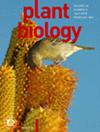通过行配置优化西南玉米-大豆间作的光合作用、资源利用效率和产量
IF 3.6
3区 生物学
Q1 PLANT SCIENCES
引用次数: 0
摘要
间作在西南地区广泛应用,但优化地上光利用和通过行配置提高光合能力以提高生产力的研究还很有限。本研究采用随机区组设计,系统比较间作与单作制度以及间作制度内不同行构型的光合性能、资源利用效率和产量优势。间作玉米的光合作用(Pn)、叶面积指数(LAI)、干物质积累(DMA)和截获光合有效辐射(IPAR)分别提高了11.47%、17.72%、24.07%和9.91%。在所有配置中,玉米(3.10)和大豆(2.56)的平均LAI均以M2S4配置最高。LAI越高,光截获能力越强,玉米和大豆的IPAR值分别为84.78%和73.67%,从而提高了辐射利用效率(RUE)。在M2S4配置下,Pn(玉米增产8.51%,大豆增产11.95%)和DMA(玉米增产14.95%,大豆增产32.67%)均显著高于其他配置。改良Pn促进了籽粒发育,玉米千粒重(TGW)和大豆百粒重(HGW)分别提高了6.68%和6.26%,提高了总产量和土地当量比(LER)。此外,相关分析显示LAI、IPAR、RUE和LER与产量呈显著正相关。主成分分析进一步表明,M2S4配置具有最高的整体性能。本研究表明,西南地区M2S4配置下玉米-大豆间作提高了光合能力,优化了资源利用,提高了产量。本文章由计算机程序翻译,如有差异,请以英文原文为准。

Optimizing photosynthesis, resource use efficiency, and yield in maize–soybean intercropping through row configurations in Southwest China
求助全文
通过发布文献求助,成功后即可免费获取论文全文。
去求助
来源期刊

Plant Biology
生物-植物科学
CiteScore
8.20
自引率
2.60%
发文量
109
审稿时长
3 months
期刊介绍:
Plant Biology is an international journal of broad scope bringing together the different subdisciplines, such as physiology, molecular biology, cell biology, development, genetics, systematics, ecology, evolution, ecophysiology, plant-microbe interactions, and mycology.
Plant Biology publishes original problem-oriented full-length research papers, short research papers, and review articles. Discussion of hot topics and provocative opinion articles are published under the heading Acute Views. From a multidisciplinary perspective, Plant Biology will provide a platform for publication, information and debate, encompassing all areas which fall within the scope of plant science.
 求助内容:
求助内容: 应助结果提醒方式:
应助结果提醒方式:


